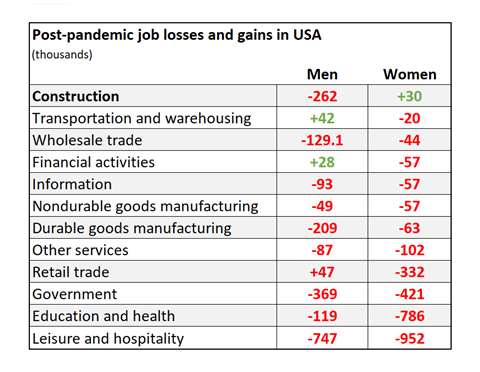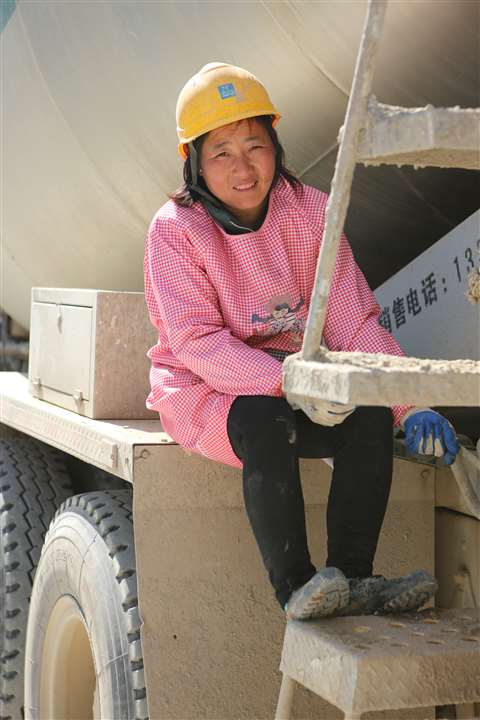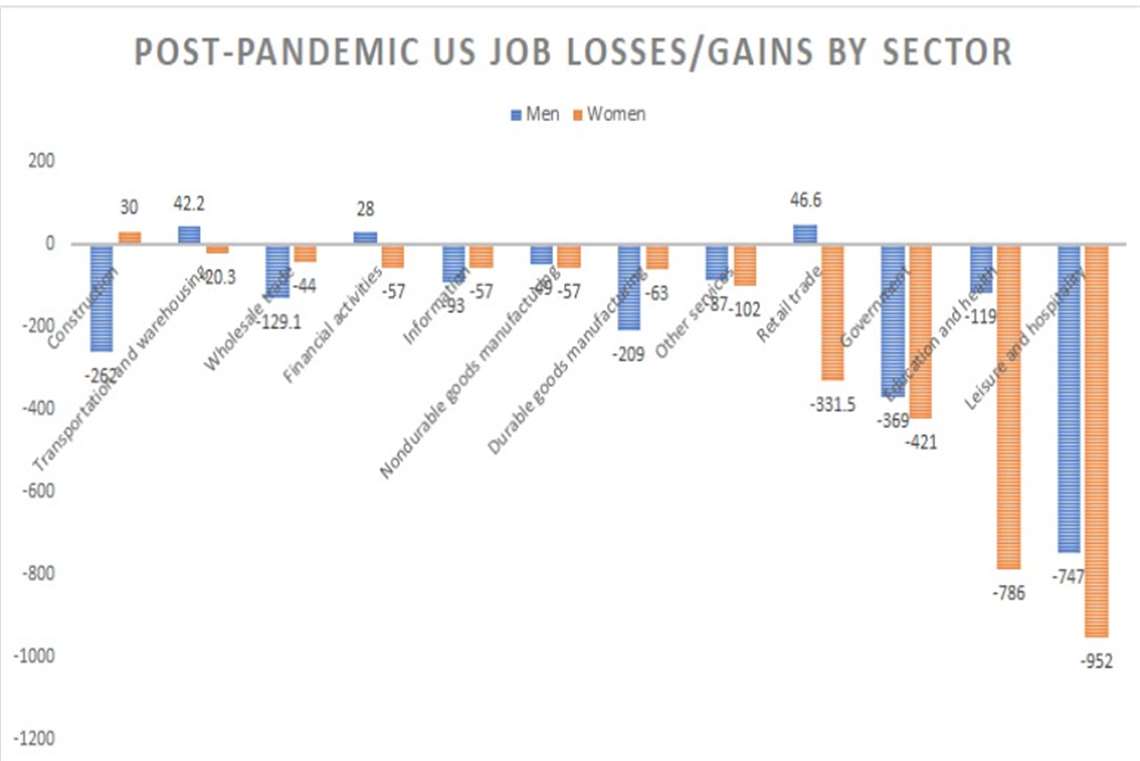Why the pandemic is encouraging more women to work in construction
16 December 2021
Construction was one of the only industries where the number of jobs held by women increased during the pandemic. Lucy Barnard finds out why and what employers can do to recruit more women during the “she-cession”
Holly Price, a director at British demolition firm Keltbray, struggles to remember her working life before the pandemic.
“I don’t know how I managed to physically get to so many meetings and to travel so much,” says the director of skills and communities, an explosives engineer by training who, until recently, also acted as president of the National Federation of Demolition Contractors.
 “The pandemic has showed us all that we can use technology like Zoom and Teams and I think that has been really beneficial for my work-life balance,” Holly Price, Keltbray
“The pandemic has showed us all that we can use technology like Zoom and Teams and I think that has been really beneficial for my work-life balance,” Holly Price, Keltbray
“The pandemic has showed us all that we can use technology like Zoom and Teams and I think that has been really beneficial for my work-life balance,” she says. “Now, if I can get online, I can work.”
Price, who started her career in the demolition sector aged 17, trained as an engineer and worked her way up to become the first female explosives expert in Europe in the sector, also works to promote diversity and attract newcomers of all backgrounds to the sector which is typically seen to have one of the most macho cultures in construction.
“I would argue that the pandemic is a golden opportunity to re-balance the construction industry as a whole,” Price says. “In the past construction companies have not always approached jobs with flexibility in mind. We haven’t questioned whether it is necessary to have every member of a team on site for ten hours a day. Covid has proved that some people can work remotely.”
Although she stresses that it is still too early to really know what the full effects of the pandemic have been on everyday life and that many demolition jobs by their very nature must be performed on site, Price says that the restrictions forced on firms could provide a very much needed kick to help the industry attract and retain more women.
“If you had asked about flexible working two years ago, I think most employers wouldn’t have understood what you were talking about and if they did, they would have said absolutely not,” she says. “Presenteeism has been a big problem in the construction industry.”
“Things were beginning to change before covid, but the pandemic has meant that people are more open to opportunities in the sector,” says Price.
Price’s view seems at odds with the situation at the beginning of the pandemic where more women than men dropped out of the workforce in order to buffer a sudden loss of childcare and shoulder the burdens of home schooling, which created what some economists have dubbed a “she-cession.”
And add to that the fact that unlike the “man-cessions” of the 1970s which affected heavy industries such as construction and manufacturing, the sectors most affected by successive lockdowns have happened to be the service sector – restaurants, retail, childcare and education – where over half of employees are female.
 Credit: BLS Data.
Credit: BLS Data.
Yet, figures from the Bureau of Labor Statistics (BLS) and analysed by thinktank Institute for Women’s Policy Research (IWPR), show that although women in the US made a collective net loss of more than 3 million jobs between February 2020 and September 2021, the construction sector was one of the very few industries where the number of jobs held by women over that period actually increased by 300,000.
“Three hundred thousand jobs may not sound like much but when you think about it, that’s slightly more than the total number of dental assistants in the US which is generally considered a fairly typical female profession,” says Ariane Hegewisch, who leads the Employment and Earnings programme at the IWPR.
“This current trend is genuinely new,” Hegewisch says. “In previous downturns women lost more jobs than men in the sector but this time women actually increased their share of jobs.”
Certainly, the need for more women to enter and remain in construction industries across the developed world is painfully clear. Before the pandemic, McKinsey estimated that women make up just 12% of the global construction industry – around 8% in the EU, 10% in the US, 11% in the UK, 12% in Australia and 13% in Canada.
Even in Sweden, a country which boasts one of the first feminist governments in the world, men comprise 89.8% of the construction industry while women only account for 10.2%.
 Keltbray’s Price sees new opportunities for women in so-called ‘green construction’ roles such as environmental engineers or sustainability consultants. These are often less site-based than other construction roles and allow more flexibility. “There are lots more opportunities for women in the construction sector than there were because there are more expectations on contractors,” she says. “The whole scope of what we do has changed. This new work is creating new opportunities and some of these are attracting women. We’ve been recruiting for net zero sustainability roles and women have been drawn to these roles.” But IWPR’s Hegewisch is concerned that by encouraging women into specific “green” construction jobs, the industry risks creating silos, trapping them in lower-wage sectors and restricting job prospects in future. Photo: Martin Barraud/Caia Image
Keltbray’s Price sees new opportunities for women in so-called ‘green construction’ roles such as environmental engineers or sustainability consultants. These are often less site-based than other construction roles and allow more flexibility. “There are lots more opportunities for women in the construction sector than there were because there are more expectations on contractors,” she says. “The whole scope of what we do has changed. This new work is creating new opportunities and some of these are attracting women. We’ve been recruiting for net zero sustainability roles and women have been drawn to these roles.” But IWPR’s Hegewisch is concerned that by encouraging women into specific “green” construction jobs, the industry risks creating silos, trapping them in lower-wage sectors and restricting job prospects in future. Photo: Martin Barraud/Caia Image
And, for site-focused roles, they comprise just a tiny fraction of workers with women representing just 1-2% in the UK and nearly 4% in the US.
“Construction jobs tend to be well-paid when compared with other work that does not need a college degree, so for many years, entry-ways into the trades have been tightly guarded,” says Hegewisch.
“Construction is a hands on-profession and, unlike jobs where you need to pass an exam and then, once you pass, that can’t be taken away, if you want to acquire the skills needed for a construction job then you need to be taught on the job by a man.”
Post-pandemic boom to lead to more diversity
She believes that the post-pandemic boom in construction, coupled with a chronic shortage of skilled workers could act as a catalyst to make the industry more diverse.
She points out that during the pandemic most countries and states not only treated construction as an essential service which was allowed to continue during lockdowns, but governments have also invested heavily in construction and infrastructure projects as part of a plan to kick-start the economy and create more jobs.
Although construction workforces fell slightly at the start of the pandemic, state capital investment projects coupled with a housing boom prompted by a shift in preference to larger homes in towns and suburbs, led to a swift recovery which triggered a rapid increase in vacancies. In the States alone, Joe Biden has signed a US$1.2trn infrastructure bill which could create thousands of jobs.
In the past, younger workers tended to bear the brunt of job cuts during recessions while older managers were often the ones keeping their jobs. But, says Hegewisch, the aging demographic of the construction sector, this time around has meant that when the pandemic hit, a significant number of the baby boomer generation saw it as a natural segue to early retirement.
Certainly, in many developed countries, the construction industry has struggled to recruit and retain staff since the 1970s and 1980s. According to US government figures, in 2018, around 22% of construction workers were aged 55 and over – up from just under 17% in 2011. UK statistics paint a similar picture, with the 2011 census estimating that one in every five UK-born construction workers was aged over 55.
“Even before the pandemic, the US economy was booming which meant that white men who might otherwise have gone into construction could go elsewhere and get better paid, less strenuous jobs. So in some areas of the US, we have seen more women recruited into the trades,” Hegewisch says.
In Sweden too, experts say that the pandemic is helping existing efforts to diversify the industry.
“The pandemic has been an opportunity for the Swedish construction industry to move forward with women’s issues,” says Elin Kebert, competence expert at the Swedish Construction Federation.
“The construction industry in Sweden has had a very macho culture – if you feel ill, take an aspirin and go to work. Man up. But with the start of the pandemic, I think it was very important for many workers to hear our [then-prime minister], a man with a strong trade union background, saying the opposite. If you’re sick, stay home. If your kids are sick, stay home. The Swedish covid strategy does affect attitudes and is helping to make the industry a better and more flexible place to work for women – and men.”
Kebert says that since the start of the pandemic the number of applicants to higher vocational education programmes backed by the Swedish Construction Federation seeking to fast-track older professionals into site manager positions have increased rapidly. In 2021, 32% of the 5,494 students that started a “Higher VET” programme within construction and engineering were women.
Construction labour shortages in Sweden
“The post-pandemic boom has definitely created a labour shortage in Swedish construction,” she says. “There are building and construction projects going on throughout Sweden so employers are competing to hire skilled construction workers. Employees are able to choose where to work - both men and women are saying, why should I travel long distances to big building sites when I can work close to home, be an active parent and not miss my kid’s dance class. Young professionals want a better work/life balance. “
Women are mostly attracted by the career opportunities and good wages,” Kebert says. “Building sites are usually operating at the times that day care centres are open. And the work gives them a chance to develop highly desirable and transferable skills.”
 A worker mixes concrete at a construction site in Zhengzhou city in central China’s Henan province - Reuters
A worker mixes concrete at a construction site in Zhengzhou city in central China’s Henan province - Reuters
Susan Moir, research director for the Policy Group on Tradeswomen’s Issues (PGTI), points out the low proportion of women working on construction sites is only a problem in rich countries where construction workers stand to make good money compared with other non-skilled and semi-skilled jobs.
In 2018 in China, according to the National Bureau of Statistics, 14% of all construction workers were women, comprising a workforce of some 9.5 million. In Nigeria, researchers estimated women make up 16.3% of construction workers.
“There are plenty of women working on site in the global south where they are poorly paid and doing the heavy lifting and carrying,” Moir says. “In the global north women have traditionally been excluded from these high paying jobs.”
“There is a serious labour shortage in the US construction industry,” Moir says. “The sons and nephews of the traditional white male workforce are not entering the industry. Their families had the resources to send them to collage and they are working white collar jobs. On the other hand, women, especially women of colour, haven’t had these opportunities. These are people earning US$8 per hour, probably working two jobs and juggling childcare. Doing hard physical work in nursing homes or in hospitality. They are seeing an opportunity. A skilled tradesman in the US can make around US$100,000 a year.”
In the US, Moir says that the reason that the percentage of women working on-site in construction has increased to nearly 4% - from around 3% before the pandemic - is because in three regions in the country, Massachusetts, Greater Seattle and Metro, Portland, Oragon, have succeeded in increasing numbers of women on site to more than 10%, dragging up the national averages.
Total amount of minorities and women in construction
She says that in these particular areas, organisations like hers, have been pursuing a strategy of encouraging government agencies and contractors to include agreements in their construction contracts requiring that a proportion of the total amount of work is done by women and minorities. This is then monitored, usually on a monthly basis. Then, if the monitoring committee finds that women and minorities are not being offered enough work, they can call in the manager in question for a meeting. If no improvement is made after several meetings then the owner has the right to initiate fines.
Moir says this “integrated supply and demand” model is already such a success that the team is hoping to export the model to yet more cities across the states and beyond. A delegation of North American tradeswomen to London has already been planned next year where Moir and her colleagues plan to exchange best practice with developers, contractors, unions and community groups.
“Organisations like ours have been trying to get more women into the construction trades since the 1970s,” Moir says. “We established training courses. We were bringing women to the door of the industry and a few of them even got in and got jobs but we were finding that very few of them made it beyond that. By working with employers who want to be seen to do the right thing, we find we’re having much more success. We go for the low-hanging fruit.”
How to recruit more women in the construction industry
Yet, campaigners say that, as well as ensuring that they recruit more women to the construction industry, employers must also take steps to promote women to more senior, better paying positions (see Gender Pay Gap box) and ensure that they also retain staff - of all genders - by creating more inclusive cultures.
Hegewisch points out that, despite many companies implementing programmes and courses to address workplace prejudice, discrimination and harassment translate each year into the industry haemorrhaging thousands of jobs.
In November, she conducted a survey of 2,600 tradeswomen which found that 40% said they had seriously considered leaving the industry because they had been made victims of discrimination or harassment, or that they were being held to a different standard to their male counterparts.
“A safe workplace, free from harassment and discrimination is the right of any worker,” says Hegewisch. “We’re only undercutting our own workforce and infrastructure rebuilding efforts if women don’t feel welcome or safe in the construction industry and walk away from or don’t seek out these important jobs. Ultimately, we want to make it a better, more welcoming industry for everyone.”
In recent years, the introduction of mandatory gender pay gap reporting in countries including Sweden, Australia, France and the UK, has shown a stark difference in the salaries paid to men and women across the industry.
Numbers published by large construction businesses continually show that the average woman in the construction industry is paid up to a third less than her male colleagues.
UK law firm Pinsent Masons, analysed the gender pay gap reports published by 118 construction employers in the UK during the year 2020-21. It calculates that on average, contractors paid the men they employed around 20% more than the women. Men also received an average of 20% more in bonus payments during the year compared with their female colleagues.
“As a historically male-dominated sector, construction has traditionally reported one of the largest gaps in the average earnings of male and female employees. While many companies have strategies to measure and address diversity in place, there is still not equal representation, as shown by the data,” says Susannah Donaldson, legal director at Pinsent Masons. “It is particularly apparent that fewer women occupy senior or more highly paid roles within the sector, and it tends to be that the majority of new recruits are predominantly male.”
During the early months of the pandemic however, lay-offs, pay cuts and furlough schemes, appear to have all acted to skew the figures. For the first time ever, housebuilder Taylor Wimpey reported a median hourly pay rate in favour of women in 2020-21, with female staff earning £1.18 for every £1 earned by men, because site staff, who are predominantly male, were furloughed at the time of the snapshot, while predominantly female sales staff were not furloughed until a later date. On the other hand, Redrow Homes reported gender pay gap of 49.4%, but acknowledged that the report was skewed by Covid-19 as it excluded 81% of employees who were furloughed at the time of the snapshot.
“The pandemic has shown employers that have been slow to embrace flexible and remote working practices the extent to which such arrangements can work for their business, as well as for their people,” Donaldson adds. “Flexible working practices and policies have been identified as key to attracting and retaining female staff and improving gender equality, and while there are many roles in the construction space which cannot be done remotely it appears that many companies in the sector are actively seeking to promote and encourage agile working practices where possible.”
| Company | Gender Pay Gap 2020-21 |
| ACS, Spain | 26.7% (female senior management and university graduates earned an average salary of just €56,726 while their male counterparts earned on average €77,384) |
| Hotchief, Germany |
11.5% for executives, 11.2% for managers, and 15.9% for those at a non-manager level |
| Mace, UK | 31.2% mean gender pay gap; 36.4% median pay gap. The Group’s mean bonus gap stood at 52.9%. |
| Keltbray | 24.1% “official” mean gender pay gap - normalised to 25.73% when including those on furlough and making salary sacrifices |
Source: Company Gender Pay Gap reports
STAY CONNECTED



Receive the information you need when you need it through our world-leading magazines, newsletters and daily briefings.
CONNECT WITH THE TEAM









